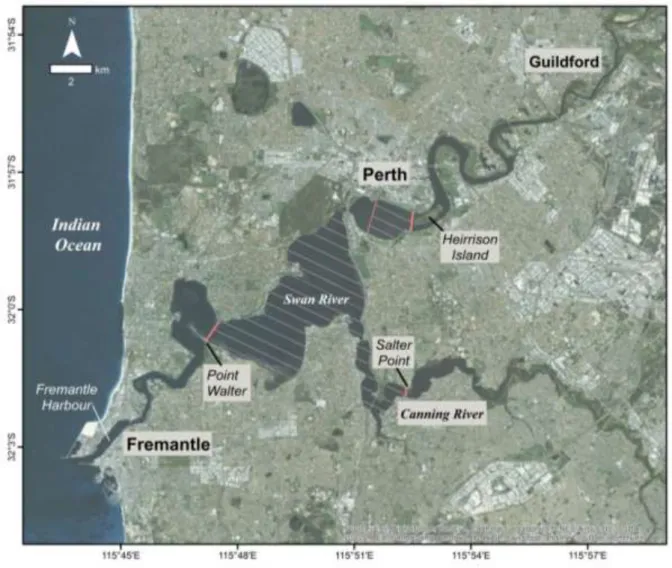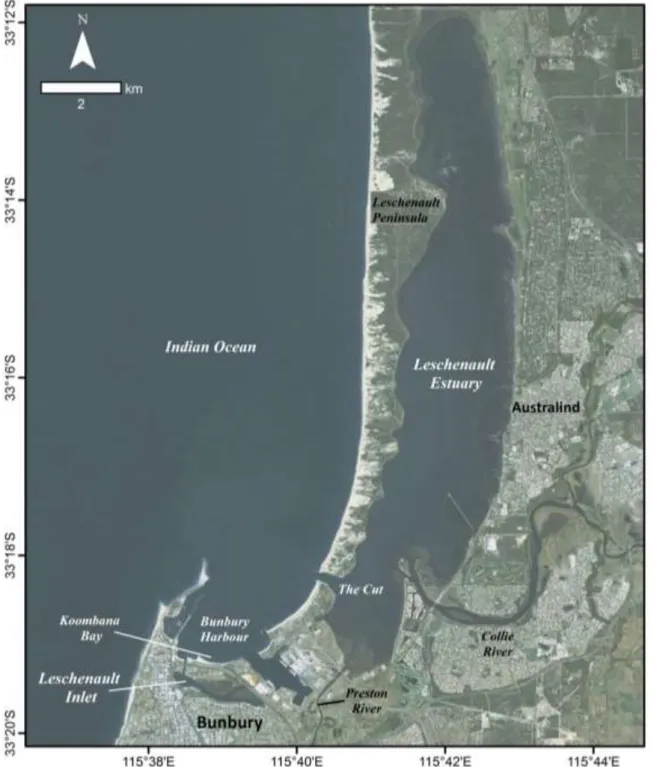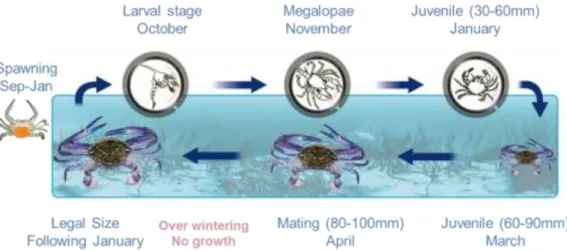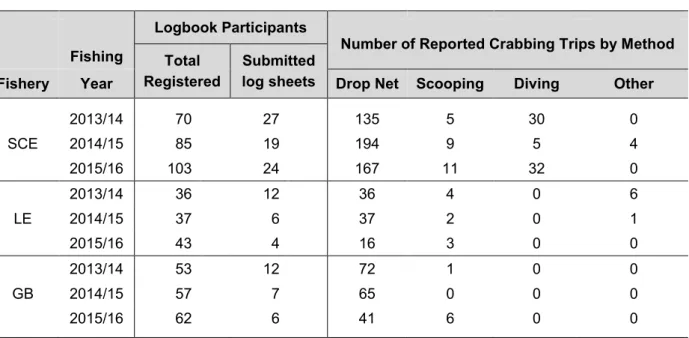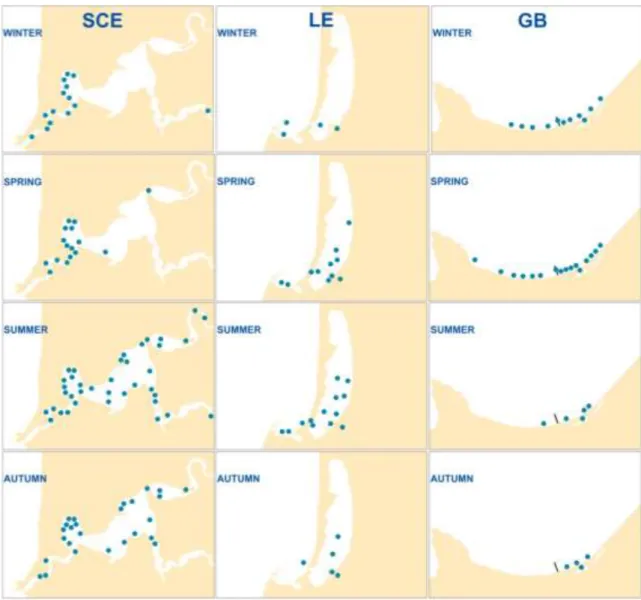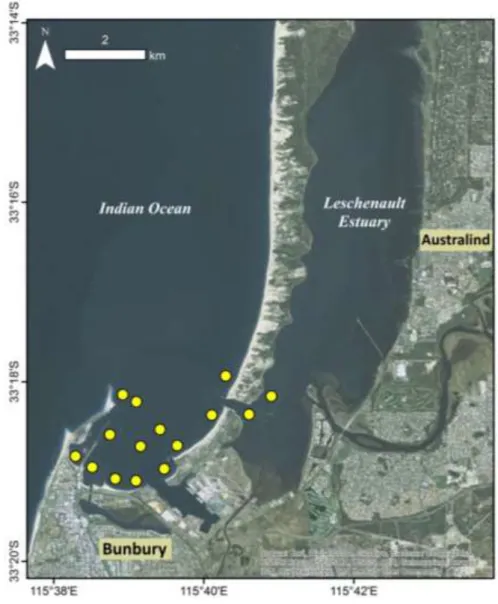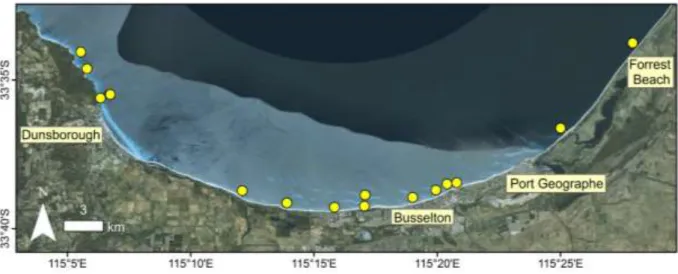Develop methods to continuously assess blue crab recruitment and reproduction in SCE, LE and GB. Tagging field surveys have shown clear movement patterns among blue swimmer crabs in the SCE.
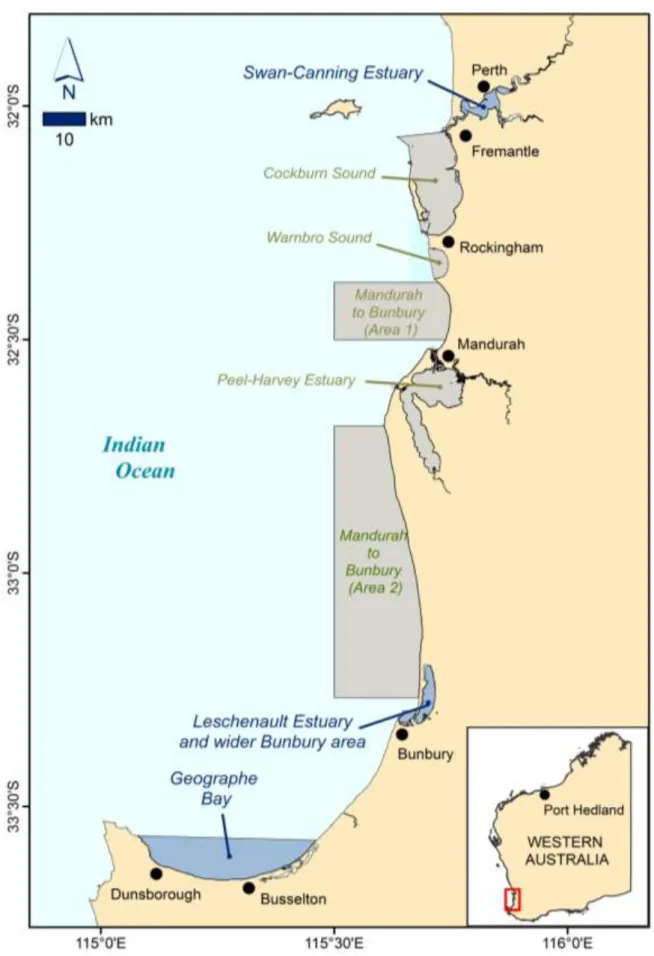
The Swan-Canning Estuary
Physical description
Aerial photograph of the Swan-Canning Estuary, including the boundaries ( ) of Area 1 of the commercial West Coast Estuarine Managed Fishery.
Recreational crab fishery
Commercial crab fishery
The Leschenault Estuary and wider Bunbury area
Physical description
Recreational crab fishery
Most of the recreational crayfish fishery in LE in 1998 occurred during the summer months, accounting for 70% of the boat fishery and 82% of the shore fishery. These seasonal fluctuations in crabbing effort and catch rates reflect changes in estuarine water parameters through the seasons.
Commercial crab fishery
Potter and de Lestang (2000) reported that estuarine crab numbers peaked from late spring through summer into early fall, when salinities and water temperatures are at their peak. However, crab numbers begin to decline from late autumn and the majority leave the estuary as salinity and water temperature drop.
Geographe Bay
Physical description
Nine short rivers and large streams drain the Cilier Range and/or Swan Coastal Plain and flow into GB. Many of the stream systems and the lower reaches of these rivers and streams have been modified in whole or in part as part of artificial drainage systems to drain the low and now cleared Swan Coastal Plain and thus enable it to be used for farming. milk and other forms. of agriculture (Waters and Rivers Commission, 1997).
Recreational crab fishery
As a result, the region is faced with the stress of excess nutrient loading to the coastal waterways and the adjacent marine ecosystem resulting in highly harmful toxic algal blooms that frequently occur in the fresh and estuarine waters of the region. The most popular area for crabs during the survey was in the vicinity of the Port Geographe Marina, from the Busselton Jetty east to the Wonnerup Estuary (Fig. 2.8).
Commercial crab fishery
Recreational crabbing regulations in Western Australia
The license entitles anglers to a maximum catch of 20 (West Coast Bioregion) and 40 crabs (elsewhere in Western Australia) per motor vessel per day, provided two or more RFBL holders are on board. Recreational swimmer blue crab possession limits per angler per day for shore crabbers, non-powered crabbers and divers compared to boat crabbers in the West Coast Bioregion (WCB) and for the rest of Western Australia (WA).
Blue swimmer crab biology in southwest Western Australia
However, a possession limit of 10 (West Coast bioregion) and 20 (elsewhere in Western Australia) crabs per boat per day applies if there is only one person holding an RFBL, regardless of the number of anglers on board. The growth cycle over the first 12-15 months of the blue swimmer crab, Portunus armatus, in south-west Western Australia.
Study objectives
Genetic studies have shown that populations of blue swimmer crabs separated by distance along the Western Australian coastline are generally independent of each other, such as Shark Bay, Cockburn Sound and Peel-Harvey Estuary (Chaplin et al., 2001). However, recent research has shown that crab populations in neighboring habitats, such as Cockburn Sound and its adjacent water bodies of SCE and Warnbro Sound, are genetically similar suggesting that limited stock mixing is occurring between these bodies. adjacent aquifers (Chaplin and Sezmis, 2008).
Introduction
Although programs for recreational anglers can generate useful information about recreational fishing, it is essential that proponents of such programs be aware of the biases that can be introduced into the data from self-selection to the pattern and behavior of anglers (Pollock et al., 1994). . This selection affects whether the sample is representative of the population and the ability to weight sample data to determine population estimates (Pollock et al., 1994).
Methods
True Blue Swimmer Supporter Initiative: Logbook participants
For example, fishermen may contribute to biases by exaggerating the number and size of fish reported, not reporting unsuccessful trips or responding to surveys, or by misinterpreting survey questions and methods (Pollock et al., 1994; Mossindy and Duffy, 2007). . Fishermen were contacted after each set of log sheets was received to validate the data and gather additional information about their crabbing experience and perceptions of crab stock status in their fishery.
Fisher engagement
In addition to these seminars, logbook participants were invited to participate in breeding stock and recruitment surveys and SWRCP tagging components. The surveys provided each participant with hands-on experience of the type of fieldwork undertaken by the DoF and provided them with a better understanding of the aims and objectives of these SWRCP components.
Statistical Analysis
Results
- Participation rates, fishing frequency and demographics
- Fishing effort
- Boat vs shore fishing
- Catch by method
- Drop net catch and effort
- Other crabbing methods
Generalized crab locations by season for SWRCP anglers in Swan-Canning Estuary (SCE), Leschenault Estuary and the wider Bunbury (LE) area and Geographe Bay (GB) between June 2013 and May 2016 inclusive. Catch and effort statistics for SWRCP anglers using nets in Swan-Canning Estuary (SCE), Leschenault Estuary and the wider Bunbury (LE) area and Geographe Bay (GB) between June 2013 and May 2016 inclusive.
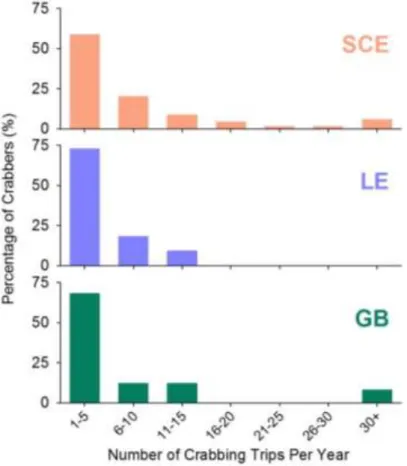
Discussion
Most of the effort in the SCE occurred during the summer and fall, with fishing taking place in most of the estuary. The large size of crabs from the recreational catch in the SCE is also consistent with the commercial history of inland capture. December commercial monitoring observations at SCE will be 154 mm CW, increasing to 160 mm CW by April.
Introduction
Objective: To develop methods for the ongoing assessment of blue swimmer crab breeding stock and recruitment in the Swan-Canning Estuary, Leschenault Estuary and the wider Bunbury area, and Geographe Bay. This chapter presents cost-effective surveys designed to provide data to generate annual indices that quantify the state of the blue swimmer crab brood stock, and the strength of subsequent recruitment, in the SCE, LE, and GB.
Methods
Breeding stock surveys
- Survey design
The distribution of catch rates of sexually mature female crabs, by number and weight, in a given year (across two sampling months and multiple sampling sites) was then used to produce an average annual catch rate and associated 95% confidence limits. The probability of sexual maturity of each individual crab (see equation (1) above) was used to calculate the number of sexually mature female crabs of a given carapace width that had the potential to produce eggs. The distribution of catch rates in a given year (across two sampling months and multiple sampling sites) was then used to obtain an average annual catch rate and its associated 95% confidence limits.
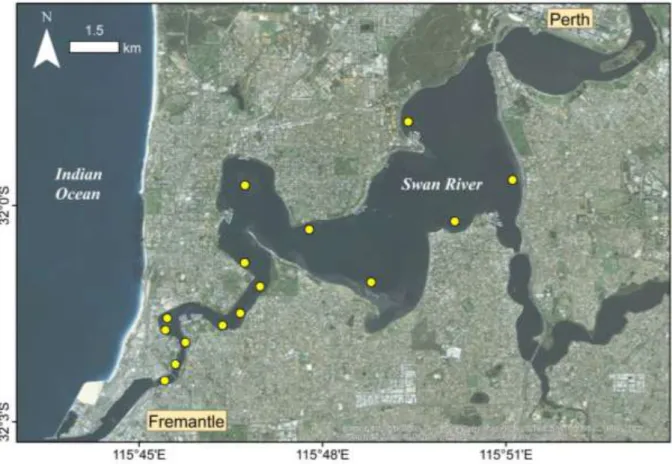
Recruitment Surveys
- Swan-Canning Estuary
- Leschenault Estuary and wider Bunbury area
- Geographe Bay
However, very few juvenile crayfish were trapped, so this method was not used in this fishery. Beach trawling was used to sample juvenile blue swimmer crabs during LE recruitment surveys in each year of the SWRCP. Although large quantities of mature crayfish were caught in the March and April surveys, very few of the target subadult crayfish appeared in the catch.

Results
Breeding stock surveys
Mean annual catch rates (number of crabs/trap) of sexually mature (SCE: ≥ 93 mm CW; LE: ≥ 94 mm CW; GB: ≥ 92 mm CW) blue swimmer crabs caught in research hour glass traps during breeding stock surveys in the Swan-Canning Estuary (●) , Leschenault Estuary and the wider Bunbury area (●) and Geographe Bay (●) between 2013 and 2015. Mean annual catch rates (number of eggs/traps) for breeding stock potential generated from breeding stock surveys in Swan-Canning Estuary (●), Leschenault Estuary and the wider Bunbury area (●) and Geographe Bay (●) between 2013 and 2015. Sexually mature female crabs were also captured at all 15 sites sampled during breeding stock surveys in LE between 2013 and 2015.
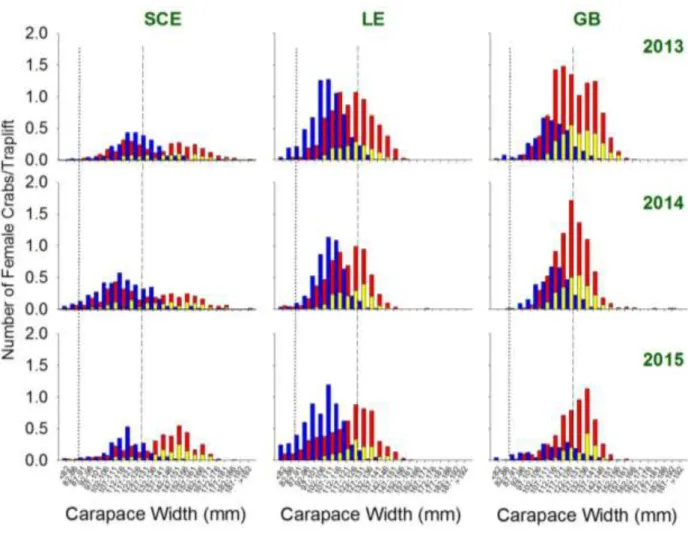
Recruitment surveys
Monthly length frequency distributions of male (█) and female (█) blue swimming crabs caught by either seine (2014 and 2015) or otter trawl (2016) during recruitment surveys in the Swan Conservation Estuary. A cohort of equal numbers of male and female subadult crabs with an average carapace width of ~70 mm was evident in the distribution in March 2016. However, very few blue swimming crabs were captured in the fords in both surveys (Fig. 4.23).
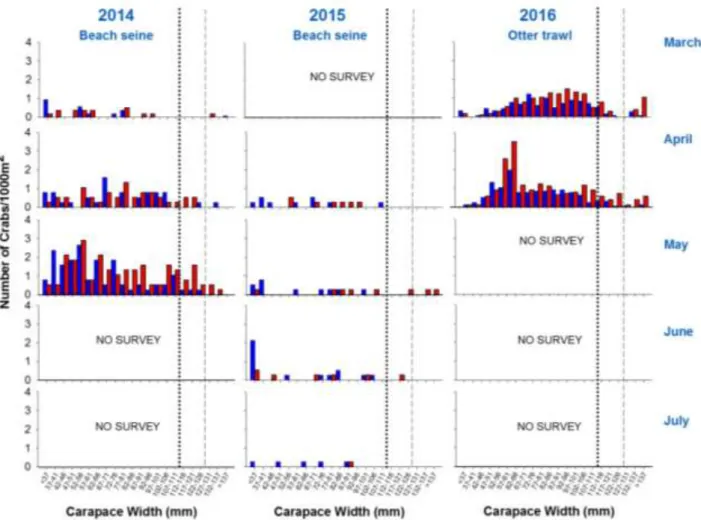
SWRCP fisher participation in sampling surveys
DoF research associates and SWRCP fishers perform juvenile recruitment sampling at Pelican Point in the Leschenault Estuary during the South West Recreational Crabbing Project. DoF research associates and SWRCP fishers conduct breeding surveys during the South West Recreational Crabbing Project.
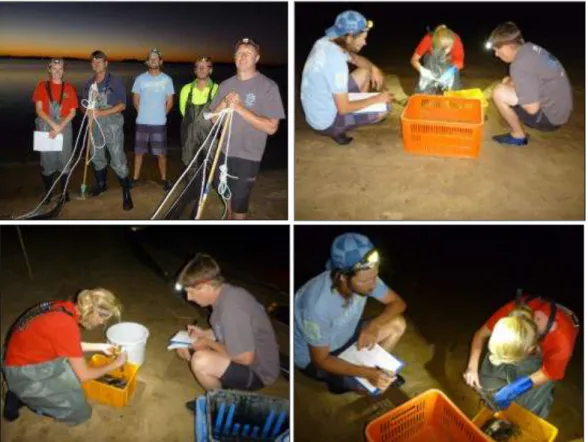
Discussion
Thus, while mean annual catch rates of sexually mature female crabs were higher in the LE and GB than in the SCE, the breeding potential of the respective stocks was more comparable. Most sexually mature female crabs in the SCE were consistently found in the lower Swan River downstream from Bicton. Beach seining proved to be an effective method for the ongoing assessment of blue swimmer crab recruitment in the LE.
Introduction
The primary objective of this component of the Southwest Recreational Crabbing Project (SWRCP) was to determine the effectiveness of tagging methods in providing information on the movement of blue swimming crabs in the SCE, LE, and GB and their adjacent marine environments. While the study was successful, the limitations of the glue-on tag were evident as recaptures ceased to be reported after the tag was lost during the peak shedding period. Two aquarium experiments examined the retention rate of the T-bar tag across a moult without adversely affecting the animal, while another field study in SCE was conducted to determine the effectiveness of the tag in providing information on the movement of blue swimming crabs within the estuary.
Methods
- First field survey: short-term marker (GT)
- First aquarium trial (ST)
- Second aquarium trial (MT)
- Second field survey: long-term marker (MT)
- Statistical analysis
- Environmental parameters
A schematic diagram of the coffin tanks used during the first and second aquarium trials. b. and c.). Application of ST to (a.) the muscle tissue between the first and second leg on the right side, and (b.) the right swimming muscle of P.armatus. Forty-eight of the crabs were used in the trial, with the remaining 17 held as spares during the 5-day acclimation period.
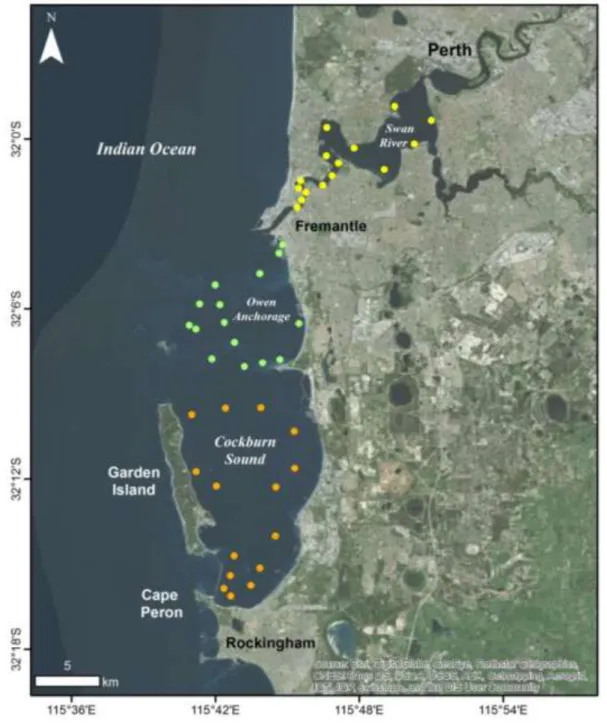
Results
- First field survey: short-term marker (GT)
- First aquarium trial (ST)
- Second aquarium trial (MT)
- Second field survey: long-term marker (MT)
- SWRCP fisher participation in tagging field surveys
A total of 3,267 blue swimmer crabs were tagged during the second field survey in SCE between March 2015 and February 2016. Number of blue swimmer crabs tagged with either only GT (GTO), only MT (MTO) or dually tagged with both GT and MT (GTMT) and the proportion of reported recaptures (%) of each treatment during the second field survey in the Swan-Canning Estuary between March 2015 and February 2016. Number of blue swimming crabs tagged between March and October 2015 with either a GT only (GTO) or double tagged with both GT and MT (GTMT), and the proportions of reported recaptures (%) of each treatment during the second field survey in the Swan-Canning Estuary.
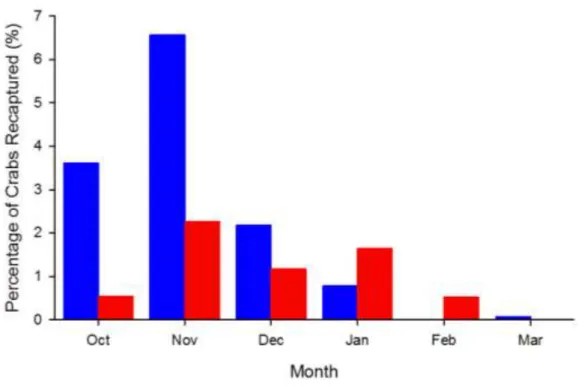
Discussion
Status of the blue swimmer crab fishery in Shark Bay, Western Australia: fishery assessment document. Overview of the biology and exploitation of the blue swimming crab, Portunus pelagicus Linnaeus, in Western Australia. Biology of the blue crab Portunus pelagicus in the Leschenault Estuary and Koombana Bay, SW Australia.
Site location details
Recruitment survey sites for the Swan-Canning Estuary (SCE), the Leschenault Estuary and wider Bunbury area (LE) and Geographe Bay (GB) sampled between March and May of each year from the SWRCP. Site locations of the Glue-on Tagging Survey in the study areas of Owen Anchorage (OA) and Cockburn Sound (CS). Mark site locations for the second field survey in the SCE running from March 2015 – March 2016.
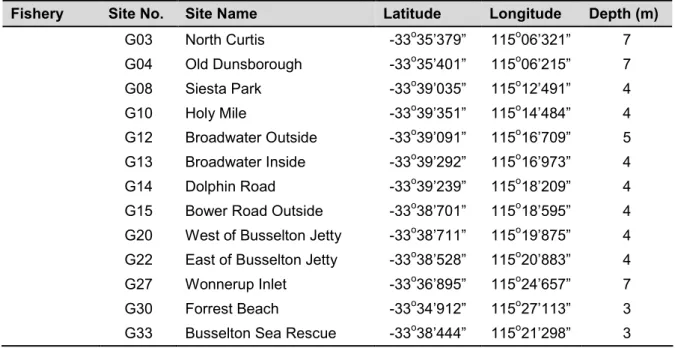
Tag recapture information sheet
